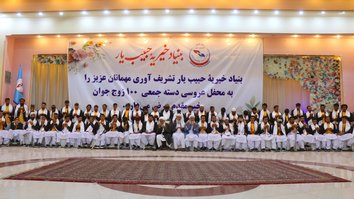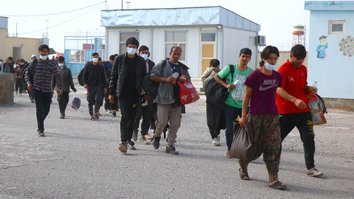BAGHLAN -- Dozens of female entrepreneurs and artists in Baghlan Province held an exhibition showcasing their handicrafts while also calling on authorities to stop the import of low-quality goods, including from China.
The exhibition was held from February 7-9 in the Bala Dawri area of Pul-e-Khumri city, capital of Baghlan province. Both men and women were allowed to visit the exhibition.
The exhibition's 36 booths showcased handicrafts such as Afghan traditional dresses (Gand-e-Afghani), embroidered dresses with beading, embroidered silk, Baluch and Afghan waistcoats and woven clothes with various designs.
Other products included purses, hats and scarves, as well as food.
![Women visit handicrafts at an exhibition in Pul-e-Khumri, Baghlan province, February 9. [Courtesy of Abdul Hameed Rezwani]](/cnmi_st/images/2023/02/15/40780-a__1_-585_329.jpg)
Women visit handicrafts at an exhibition in Pul-e-Khumri, Baghlan province, February 9. [Courtesy of Abdul Hameed Rezwani]
"Our people should use women's handicrafts instead of buying low-quality Chinese ... clothes. From now on, women should show more courage, produce more and sell their products in the markets," said Suraya Ahmadi, 38, a resident of Baghlan and a female artisan.
"We are confident that products and handicrafts produced by women are of much higher quality than imported products, because they are made of better materials," she told Salaam Times.
"If we give each other a hand, support our domestic products and say no to low-quality products from China and other countries, their imports will automatically stop," she added.
"Afghan clothes and products represent our culture," said Nafisa Ayar, 36, a female entrepreneur from Baghlan.
"If we stop the use of imported clothes, especially Chinese clothes, I am sure that women's handicrafts will develop and the day will come when we export our domestic clothes," she said.
"We still cannot compete with imported products. The government must increase tariffs and tax on imported products so that the public benefits from domestic products," she added.
"My message to the families who can produce handicrafts but can't distribute them to the markets is that we are trying hard ... to support women's handicrafts in their marketing," said Assadullah Mustafa Hashemi, director of the Baghlan Department of Information and Culture.
"The goal of this exhibition is to promote handicrafts, support household incomes, find markets for women's handicrafts and encourage [customers] to buy them," he told Salaam Times.
He urged Afghans to buy domestically made clothes instead of imported ones.
Efforts for a better future
Such exhibitions offer a good opportunity for the sale of women's handicrafts even as women continue to face restrictions.
"The exhibition is helpful to those women who want to become self-sufficient. We showcase women's products so that other women and girls can use them," said Laila Kazemi, 35, a female artisan in Baghlan.
Kazemi said she is happy that her products, including clothes and purses, were sold in the three days of the exhibition.
"Holding such exhibitions supports women's businesses and encourages them to do more work," she told Salaam Times on February 9.
"I am very happy today that I get to showcase my products in the exhibition. I try for a better future so that I can improve my household income," she said.
"In the current situation in which women can't work and study, holding such exhibitions is a breath of fresh air and a good opportunity for women who want to be active," said Nadia Mohammadi, 26, a visitor to the exhibition.
"The exhibition will support women's earnings and businesses, and in order to improve and increase the sale of domestic products, we want to draw public attention to women's businesses through this exhibition," she said.
She called on the authorities to help facilitate holding more exhibitions for women.
Low-quality Chinese goods
With each passing day, products imported from China are increasingly gaining ground in the markets in Mazar-e-Sharif and are sold at very low prices, said Ziaullah Salarzai, 33, a shopkeeper in the city.
"Clothes sold in the markets are mostly Chinese. Unfortunately, [customers] prefer buying them as they are cheaper than quality domestic clothes," he told Salaam Times.
"Various men, women, and children's clothes and even toys in the market are made in China," he said.
"Since our people are poor and cannot afford quality products, they have to buy low-quality Chinese clothes."
Since Afghans suffer from poverty and the majority cannot afford expensive clothes, they buy imported Chinese clothes, said Sifatullah Mahboobi, 48, a resident of Kunduz city.
"A popular Afghan saying is 'expensive isn't without quality; cheap does not come without a defect,' which is true about the currently available Chinese clothes in the Afghan markets," he told Salaam Times.
"While Chinese clothes are of low quality, they are attractive for some. While they do not last long, buyers are willing to discard them and buy new clothes," he said.
"The prevailing trend ... especially among women, is not to wear the same clothes at two different ceremonies. Therefore, they do not want to buy expensive high-quality clothes and buy imported Chinese clothes instead."








Therefore, due to the social and cultural norms set by the Taliban, women continue to wear the burqa. More can be said about the Afghan clothes. The first traces of human habitation in Afghanistan were found about thirty thousand years ago. This ancient country is the main attraction of the historical route known as "Silk Route", which was an important passage for human migration to this region. It is true that centuries have passed, but the traditional and nomadic lifestyle of Afghan people has never changed. Respecting the geographical landscape of this landlocked country, thanks to the self-esteem of the Afghan people, the ancient cultural and traditional values are still alive and preserved in this country. The main ethnic communities of Afghanistan are Pashtuns and Tajiks. While Hazaras and Uzbeks are also significant in terms of numbers. Each ethnic group has its own way of dressing, but they all dress in similar ways. Afghan traditional dress has gone through many variations and fashions. In Afghanistan, cotton and wool remain the dominant fabrics used for sewing clothes. After the Taliban regained power, they have imposed strict regulations, especially on girls' Afghan dress. Wearing jeans or western-style pants was forbidden for men and women during the Taliban era. At the end, I would recommend again that in order to save from poverty and grow Afghan handicrafts, it should be changed and modernized so that it can contribute to the growth of the country's economy.
Reply7 Comment
Some clothes have special significance, for example in some Pashtun or Baloch cultures in southern Afghanistan, a boy marks the beginning of adulthood by being allowed to wear a turban. In Afghanistan, men, women and children generally wear loose clothes. Vests, known as Waskats, are one of the most popular men's clothes in Afghanistan, which are made of black and red velvet and embroidered. The embroidery work of Kandahar region is famous, and for this reason, the vests of this region are decorated with beautiful embroidery. Due to the dry climate of Afghanistan, women wear cotton clothes in the summer and woolen clothes in the winter. Women usually wear a knee-length dress with pants called Tunban. According to Afghan culture, light-colored shirts are worn by the younger generation and dark-colored shirts are worn by the older people. Silver jewelry is a prominent type of jewelry that is seen as a constant element in the traditional and contemporary Afghan fashion. Silver beads, coins and decorations are also sewn on women's clothes and sometimes they are combined with glass pieces, colorful beads and embroidery. It is worth mentioning that Afghan women's fashion has changed a lot since the Taliban took control of the Afghan government. By 1970s, women in Kabul had developed a tendency to wear western clothing, which included long skirts and high heels. During the Taliban rule and afterwards, most women are seen fully clothed and wearing burqas. The Taliban has created the i
Reply7 Comment
If the handicrafts made by Afghan women get modernized, it can play a significant role in improving the Afghan economy. It is true that handicrafts have been common in Afghanistan for many years, but investment should be made in facilitating its work, marketing and educating other people. Afghan handicrafts and fashion consist of rich culture and traditions that lie in every part of this country. Since Afghanistan is home to several ethnic groups such as Pashtun, Tajik, Hazara, Uzbek, Baloch, Turkman and Gurjar, Afghan culture reflects multiple ethnic groups. Afghan clothing is derived from different regions and cultures in Afghanistan, and the variety in color and design in this clothing shows the ethnic and cultural diversity in this land. It can be said that there are two different types of clothing in Afghanistan: traditional and national clothing and daily and normal clothing. There are many differences between the two. The most striking effect of women's Afghan dress or Herati dress is due to its colorfulness and patchwork that these dresses have. Women's afghan clothes are usually accompanied by embroidery, patchwork of colored fabrics, or navy blue embroidery, which is mostly seen in Afghan wedding dresses or wedding dresses. The beautiful culture and art of Afghan women have joined hands to make the Afghan dress for girls one of the most beautiful traditional and local dresses in the world. Women's Afghan clothes are usually sewn by hand. Girls start learning embroide
Reply7 Comment
Today, handicrafts are the best job for women and a good source of income for the families. On one hand, a source of income is added to their family, and on the other hand, they save them psychologically. Relief organizations should pay more attention to this type of handicrafts for women. It is the duty of the ruling government to make the same effort in marketing and impose such a heavy tax on goods imported from abroad that people are not left to buy the imported goods.
Reply7 Comment
China has taken over all the world markets. China manufactures goods for all countries of the world according to the demand of their customers. Afghan women should also think of making clothes according to the demand of our country's customers because the economy of 90% of our people does not fit as they buy expensive clothes. Afghan business women or investors can easily deal with the Chinese market, they can buy cheap pieces of cloth and give it to the women who are sitting at home unemployed, and provide the women with a sample of low-priced Chinese clothes, and tell them to match the clothes to the same figure. Nothing is impossible. Little work is needed, else, whatever a person wants, he can do it. Afghan women should make their own clothes according to the country's economy. Afghan women have another tradition, they wear one type of cloths in a program that, they don't wear in another program, and they say to the husband, buy me another dress anyway possible. If her husband says a hundred times that I can't afford to buy more clothes, the wife will not accept it. Her husband is forced to buy cheap clothes, and fulfill the desire of his wife. You women forced the men to do so, while you still complain. Women who make handicrafts should prepare and market clothes according to the market and economy of their country.
Reply7 Comment
Since the government has banned women's work and does not allow them to work, they should listen to the voice of these women and ban Chinese goods so that the merchants do not import them. Women make handicrafts at home with modesty and dignity and then present them to the market. So, what will they do if women are not allowed to go out and no market is created for them to work inside the house? Is she not a human being? Does she have no rights to be given to her? Women's voices must be heard, and their humanitarian and Islamic rights must be given to them.
Reply7 Comment
It is their right to block foreign-made goods. Because Afghan women and girls make handicrafts with their delicate fingers, but when they present them to the market, there are no buyers. Government officials should accept any request made by the Baghlani women, and not only that the import of Chinese goods should be banned; instead, sanctions should be imposed on all the goods we have inside the country.
Reply7 Comment